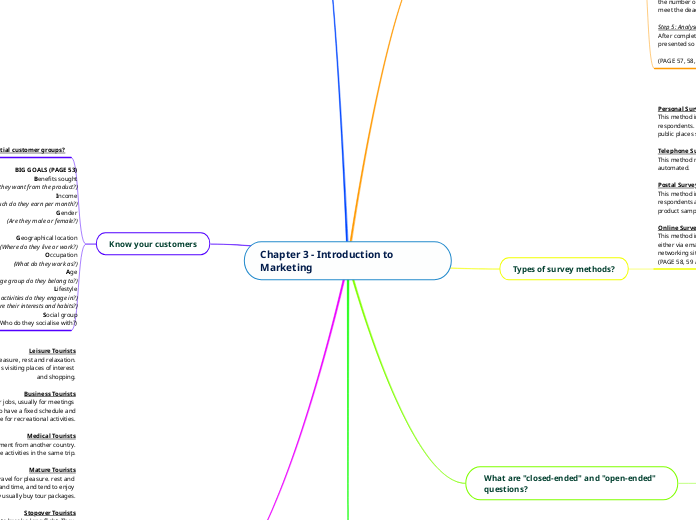Chapter 3 - Introduction to Marketing
What is Marketing?
- Identify the needs and wants of target customers
- satisfy customers in ways that are better than competitors
Name the 4Ps?
Product
(What goods and services do the customers need or want?)
Price
(How much do the customers have to pay?)
Place
(Where can the customers buy the products?)
Promotion
(How are the customers persuaded to buy the product?)
Know your customers process?
Applying the marketing mix process?
Know your customers
Identify the potential customer groups?
BIG GOALS (PAGE 53)
Benefits sought
(What do they want from the product?)
Income
(How much do they earn per month?)
Gender
(Are they male or female?)
Geographical location
(Where do they live or work?)
Occupation
(What do they work as?)
Age
(What age group do they belong to?)
Lifestyle
(What activities do they engage in?)
(What are their interests and habits?)
Social group
(Who do they socialise with?)
Types of tourists?
Leisure Tourists
They travel for pleasure, rest and relaxation.
They enjoy activities such as visiting places of interest
and shopping.
Business Tourists
They travel because of their jobs, usually for meetings
or for training. They tend to have a fixed schedule and
little time for recreational activities.
Medical Tourists
They travel to seek medical treatment from another country.
They may include some leisure activities in the same trip.
Mature Tourists
They are the elderly who travel for pleasure. rest and
relaxation. They have money and time, and tend to enjoy historical and cultural sites. They usually buy tour packages.
Stopover Tourists
They stop at a particular country to break a long flight. They usually stay for a short period of one or two nights.
Special Interest Tourists
They travel to pursue their hobbies and interests outside of their own countries. For example, a sports tourist may be a marathon runner who travels to a foreign country to participate in a marathon being held there.
(PAGE 54 & 55)
Understand Customers' Needs and Wants
What is a market survey?
A market survey is a way for a business to gather information about their customers' preferences and buying habits, in order to make a decision on the marketing mix. The actual process of conducting a market survey in the business world is very complex; some of the steps involved are shown below. (PAGE 56)
Steps of conducting market survey? Describe the steps.
Step 1: Decide on the objectives of the Market Survey
Businesses must have clear objectives at the start of a survey; tis will help them decide what questions to ask to collect the information that they need.
Step 2: Choose a Survey Method
To find out more about its target market, a business can conduct a survey by getting customers to fill out a questionnaire through several different methods.
Step 3: Design the Questionnaire
A well-designed questionnaire encourages respondents to provide relevant information that will be useful for decision-making.
Step 4: Conduct the Survey
Businesses need to set deadlines for completing their surveys. This provides a target businesses to work towards and to plan the number of respondents to approach each day in order to meet the deadline.
Step 5: Analyse the Data
After completing the survey, the data is collected and presented so that is easier to understand and analyse.
(PAGE 57, 58, 61, 62 and 64)
Types of survey methods?
Personal Survey
This method involves face-to-face interactions with respondents. It can take place at the respondent's homes or at public places such as streets and shopping centres.
Telephone Survey
This method may involve an interviewer or it may be fully automated.
Postal Survey
This method involves mailing questionnaires to potential respondents and may be accompanied by pictures and/or product samples.
Online Survey
This method involves sending questionnaires to respondents either via email or through websites, blogs and social networking sites.
(PAGE 58, 59 and 60)
What are "closed-ended" and "open-ended" questions?
Close-Ended Questions
A close-ended question is a type of question that can be answered QUICKLY by CHOOSING from a set of options like MCQs.
Open-Ended Questions
An open-ended question is a type of question that respondents can create their own answers.
Ways of presenting data?
Frequency Table
Bar Chart
Pie Chart
